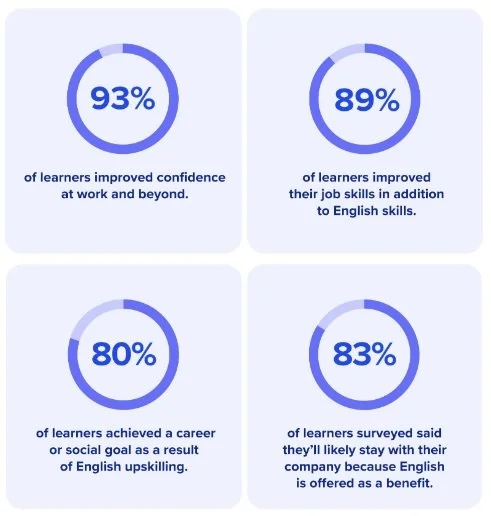Three Reasons Why English Upskilling Should Be In Your Company’s 2025 Budget
A full 90% of organizations cited employee retention as a concern in the latest LinkedIn Workforce Learning Report, and with good reason: Replacing one worker can cost anywhere between one-half to two times the amount of that employee’s annual salary. Add to that the loss of productivity and burnout that can occur due to staffing shortages, and it’s no wonder why organizations of all sizes are looking for practical strategies to better engage and retain their employees and boost ROI.
So where can your organization focus to ensure retention?
Savvy employers are turning to upskilling — specifically English upskilling — to attract and retain a high potential but largely untapped talent pool: adult English learners. This labor force already represents 1 in 10 working-age adults in the U.S. and is poised for even greater growth: Immigrant-origin workers are projected to drive 97% of U.S. workforce growth by 2030. From frontline workers to C-suite executives, employees from multilingual backgrounds play outsized roles in essential sectors like healthcare, manufacturing, hospitality, and more.
English upskilling is an innovative approach to workforce development that simultaneously equips employees with workforce-aligned English skills AND job skills. It’s also an effective investment, proven to boost employees’ job performance, confidence, and retention. As your team begins budget planning for 2025, read on for three reasons why English upskilling should be a top priority.
1/ English upskilling supports organization-wide cultures of learning.
Organizations with strong learning cultures achieve an average 57% retention rate, which is 30 percentage points higher than organizations with moderate learning cultures. It’s no wonder that “helping employers develop in their careers” jumped to No. 4 on LinkedIn’s list of workforce learning focus areas, up from No. 9 last year.
Many organizations have high potential employees that can unlock promotion opportunities and fill critical positions for their employers by improving their English. Yet in many cases, training and skill-building opportunities are offered only in English, a reality that effectively blocks adult English learners from accessing these programs. English barriers drive the sizable training gaps identified by a McKinsey & Company study: While nearly 30% of employers say they offer formal training opportunities, only 12% of frontline workers said these training opportunities are available to them.
English upskilling holds promise to fill the gap. An EnGen survey of 2,500 workers shows that English upskilling programs helped them build new skills and advance in their roles: 93% felt more confident using English at work; 89% improved their job skills; 80% achieved a career goal like a pay raise or a promotion; and 83% said they’re likely to stay with their employer because English is offered as an employee benefit.
2/ English upskilling advances employees’ English skills and digital skills simultaneously.
A full 92% of jobs in the U.S. require digital literacy — defined as the ability to access, create, and share information on computers and digital media platforms. Yet 1 in 3 U.S. workers, including 2 in 3 workers with emerging English proficiency, according to the National Skills Coalition.
It’s no wonder that 4 in 5 workers want to learn more about how to use AI and digital skills in their profession, according to LinkedIn.
Here too, English upskilling can bridge both language barriers and digital skills gaps: More than 85% of adult English learners surveyed by EnGen said they improved their digital literacy.
3/English upskilling supports employees’ well-being—on and off the job.
According to LinkedIn, employers are invested in supporting employee well-being — and recognize that these investments also support their bottom lines.
Workers seek out companies that prioritize their dignity and agency, along with their health and happiness. Access to upskilling — including English upskilling — has been shown to boost employee mental health and well-being. And in the case of adult English learners, the opportunity to learn English at work also drives tangible benefits at home, fostering a greater sense of loyalty to employers that offer these programs.
In fact, 3 in 4 adult English learners surveyed by EnGen agreed that they could navigate life better, are more engaged with their community, and help their family more as a result of English upskilling. They’re able to achieve real-world goals outside of work, like communicating with their childrens’ teachers, building community, and participating in civic processes like volunteering and voting.
Are you ready to invest in English upskilling?
At EnGen, we’ve partnered with employers across the country — from Fortune 500 companies like Amazon, Chobani, and Walmart to regional employers like Taziki’s Mediterranean Café and Rummel Construction — to offer workforce-aligned English upskilling. EnGen was built to ensure easy implementation and customization for employers of all sizes and budgets.
As your organization begins 2025 budget discussions, is English upskilling for your workers a priority? It should be. Learn how EnGen can work for your organization: https://getengen.com/demo



